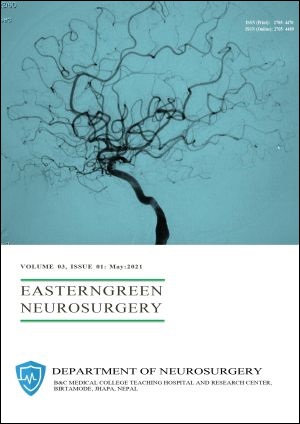Demographics, Clinical profile, Causes and Outcome of Intracerebral Hemorrhage in Neurosurgical Unit in Manipal Teaching Hospital of Western Nepal
DOI:
https://doi.org/10.3126/egn.v3i01.38963Keywords:
Demographic variables, Intra cerebral hematoma, Nepal, Outcomes, Risk FactorsAbstract
Background: This research article aims to evaluate the demographic variables, clinical profile, causes and outcome determinants of spontaneous intracerebral hematoma (SICH) in a population of Western Nepal. The study represents the cases of SICH reported from Manipal Teaching Hospital, a tertiary center at Gandaki province of Western Nepal.
Materials and methods: Retrospective data collection and analysis were done with consecutive cases of SICH admitted to our center between January 2018 and March 2019. The variables analyzed include age, gender, chronic conditions like hypertension, diabetes mellitus, history of tobacco abuse, alcohol abuse, Glasgow coma score (GCS) on admission, radiological(CT scan) findings, treatment modality, an outcome at 6 months period, etc. Modified Rankin score (mRS) was used to assess the outcome at discharge and after six months.
Results: Our study group of 237 patients included 171 males and 66 females and the mean age of presentation was 64.02 years. The study group included 121 patients (51.1%) who were previously diagnosed with systemic arterial hypertension and 15 patients diagnosed with diabetes mellitus. The most frequent locations of hematoma were basal ganglia (n=127), lobar (n=94), intraventricular hemorrhage (n=69), cerebellar (n=15) and brainstem (n=11). The mean volume of the blood clot on admission was 25.97 ml. surgical evacuation of hematoma and decompression through craniotomy was done in 52 (21.9%) patients. Independent predictors of unfavorable outcomes includes the variables like headache (p=0.007), aphasia (p=0.017), mean GCS score (p=0.00) and motor GCS score (p=0.00); CT finding of intraventricular extension of hemorrhage (p=0.00), midline shift (p=0.00), intracerebral blood volume (p=0.00); and surgery (p=0.007).
Conclusion: ICH predominantly affects a younger population in Nepal in comparison to the Western world. The variables include clinical features like headache, aphasia, pupillary size and reaction, mean GCS score and motor GCS score; CT finding of intraventricular extension of hemorrhage, midline shift, intracerebral blood volume; and surgery were the predictors of an unfavorable outcome. On binary logistic regression, the ICH score was the most consistent predictor of unfavorable outcomes in terms of MRS (OR 2.236, p=0.002).
Downloads
Downloads
Published
How to Cite
Issue
Section
License
Copyright (c) 2021 Prabin Bhandari, Suman Adhikari, Aabishkar Bhattarai, Nikunj Yogi, Balgopal Karmacharya, Bijaya Karki, Naresh Poudel

This work is licensed under a Creative Commons Attribution 4.0 International License.




